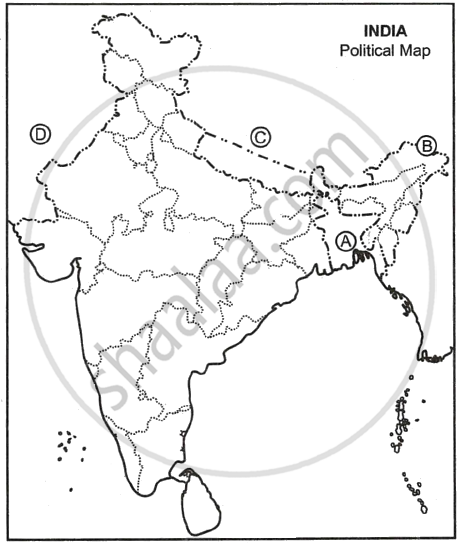Advertisements
Advertisements
In the given political outline map of India, four states have been marked as (A), (B), (C) and (D). Identify these states on the basis of the information given below and write their correct names in your answer book along with the respective serial number of the information used and the concerned alphabets given in the ‘map as per the format that follows:
| S.No.of the information used |
Concerned Alphabet |
Name of the State |
| (i) | ||
| (ii) | ||
| (iii) | ||
| (iv) |
- The state which has been bifurcated in two Union Territories recently.
- The state where Rajiv Gandhi-Longowal Accord was signed.
- The state to which Laldenga belonged.
- The state from where the Dravidian Movement started.

Concept: Integration of Princely States
Who advanced the 'Two Nation Theory' that led to the partition of British India?
Concept: Partition: Displacement and Rehabilitation
Highlight any three problems faced by Government of India immediately after independence related to the displaced population.
Concept: Partition: Displacement and Rehabilitation
Planning Commission was set up by ______.
Concept: Introduction of Politics of Planned Development
Highlight any three features of the First Five Year Plan.
Concept: The Early Initiatives
Which one of the following is not the objective of NITI Aayog?
Concept: Introduction of Politics of Planned Development
Explain any two reasons for the formation of the NITI Aayog in place of the Planning Commission by the Union Government.
Concept: Introduction of Politics of Planned Development
Read the following passage carefully and answer the questions that follow:
| India conducted a series of nuclear tests demonstrating its capacity to use nuclear energy for military purposes. After this, Pakistan also conducted tests. International Community imposed sanctions on both India and Pakistan which were subsequently waived. India opposed the international treaties aimed at non- ‘proliferation. |
- In which year did India conduct series of nuclear tests?
- 1971
- 1985
- 1992
- 1998
- Identify the treaty that India refused to sign.
- Comprehensive Test Ban Treaty
- Shimla Agreement
- Panchsheel Agreement
- Indus waters treaty
- In the beginning, India wanted to generate nuclear energy for ______.
- peaceful purpose
- making atomic bombs
- competing with the super powers
- ensuring its security
- Under whose guidance did India initiate its nuclear programme?
- C.V. Raman
- Homi J. Bhabha
- A.P.J. Abdul Kalam
- K. Kasturirangan
Concept: India's Nuclear Policy
Why did India not sign the nuclear treaties like NPT and CTBT ? Explain any two reasons.
Concept: India's Nuclear Policy
In the given political outline map of India, four countries/states have been marked as A, B, C and D. Identify these on the basis of the information given below and write their correct names in your answer book along with their respective serial number of the information used and the concerned alphabet as per format that follows:
- The country with which India fought a battle in 1962.
- The country with which India has a dispute.
- The country which came into existence after the 1971 war.
- The Indian state which shares its border with China.
| S.No. of the Information used |
Concerned Alphabet in the map |
Name of the Countries/States |
| (i) | ||
| (ii) | ||
| (iii) | ||
| (iv) |

Concept: Wars and Peace with Pakistan
Examine the major issues which led to the split of Congress part in 1969.
Concept: Congress Split and Reconstitution
Highlight the importance of the strategy of 'Non-Congressism' forwarded by Ram Manohar Lohia in the 1967 general election.
Concept: Fourth General Elections, 1967
Why is the Presidential election in 1969 in India considered 'Historical'?
Concept: Split in the Congress
Assertion (A): In 1969 the Congress Party faced a split.
Reason (R): Factional rivalry existed between the Congress Syndicate and Indira Gandhi.
Concept: Split in the Congress
Arrange the following in the chronological order:
- Appointment of Lal Bahadur Shastri as Prime Minister.
- Tashkent Agreement.
- The fourth General Elections.
- Election of V.V. Giri as the President of India.
Concept: Political Succession After Nehru
In the given outline political map of India, four states have been marked as A, B, C, and D. With the help of the information given below, identify them and write their correct names in your answer book along with the serial number of the information used and the related alphabet in the map as per the format given below:

- The state to which Jai Prakash Narain belonged.
- The State where the Indian National Congress won most of the Lok Sabha seats in the 1977 elections.
- The State from where Raj Narain contested the Lok Sabha seat against Indira Gandhi in the 1977 election.
- The State where Janata Party won all the Lok Sabha seats in the 1977 election.
S. No. of the Information used Related alphabet is given in the MAP. Name of the State (i) ______ ______ (ii) ______ ______ (iii) ______ ______ (iv) ______ ______
Concept: 1977 Elections and the Format on of Janata Party
Explain the concept of 'Total Revolution' advocated by Jayaprakash Narayan.
Concept: Navnirman Movement in Gujarat and the Bihar Movement
Who among the following had announced a nationwide satyagraha on 25th June, 1975 for the resignation of Prime Minister Indira Gandhi?
Concept: Background to Emergency
Why is the emergency imposed in 1975 considered the most controversial episode in Indian politics? Highlight any three reasons.
Concept: Declaration of Emergency
Highlight any three factors which were responsible for the downfall of the Congress Party in the 1977 elections.
Concept: Politics After Emergency
